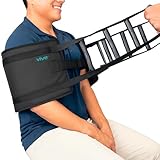Key Takeaways For Best Mobility Slings
Mobility slings are crucial tools for safely transferring individuals with limited mobility, aiding in tasks like standing, lifting, and repositioning.
Key considerations when choosing a mobility sling include size and weight capacity, material comfort, design and adjustability, and safety features such as padded support.
Compatibility with patient lifts, easy cleaning, and seeking input from healthcare professionals are additional factors to ensure optimal sling selection for specific needs.
Top Mobility Slings
Mobility slings are essential tools that help individuals with limited mobility safely and comfortably from one position to another. Selecting the suitable mobility sling is crucial, whether you need one for home care or professional healthcare settings. In this article, we will explore the best mobility slings available on the market, highlighting their key features and benefits.
Key Features to Consider:
- Size and Weight Capacity: Consider the size and weight capacity of the mobility sling to ensure it can safely accommodate the individual being lifted. Slings come in various sizes and have different weight capacities, so choose one that suits the specific needs and body shape of the person being assisted.
- Material and Comfort: Evaluate the sling’s material to ensure it is comfortable, breathable, and skin-friendly. Look for slings made from soft and durable fabrics that provide adequate support while minimising pressure points or discomfort during transfers.
- Design and Adjustability: Consider the sling’s design and adjustability features. Look for slings with multiple attachment points or loops, which allow for customised positioning and optimal weight distribution. Adjustable straps or buckles provide a secure and comfortable fit.
- Safety Features: Look for slings that prioritise safety during transfers. Features such as padded head support, leg and thigh support, and reinforced stitching contribute to the sling’s overall safety and stability. Additionally, ensure the sling has clear labelling indicating its weight capacity and proper usage instructions.
Additional Considerations:
- Compatibility: Ensure the mobility sling is compatible with the patient lift or hoist you plan to use. Different slings may have specific attachment mechanisms or compatibility requirements, so check the manufacturer’s guidelines to ensure a proper fit.
- Cleaning and Maintenance: Consider the sling’s ease of cleaning and maintenance. Look for slings that are machine washable or can be easily wiped clean. This ensures proper hygiene and prolongs the sling’s lifespan.
- Healthcare Professional Input: If you are still determining the type of sling that best suits your needs, consult a healthcare professional or occupational therapist. They can provide guidance based on the specific mobility requirements of the individual being assisted.
Summary of Mobility Slings:
Mobility slings are indispensable tools for safe and comfortable transfers of individuals with limited mobility. When selecting a mobility sling, consider size and weight capacity, material and comfort, design and adjustability, and safety features. Additionally, ensure compatibility with the patient lift or hoist and consider cleaning and maintenance requirements. If needed, seek guidance from healthcare professionals to ensure the most appropriate sling for your specific situation. With the right mobility sling, you can provide essential support and enhance the mobility and comfort of individuals needing assistance.
Frequently Asked Questions About The Best Mobility Slings:
What is a mobility sling?
A mobility sling, also known as a patient lift or transfer sling, is a supportive device used to safely transfer individuals with limited mobility. It is designed to be used with a patient lift or hoist to assist in lifting and moving individuals from one position to another.
Why do I need a mobility sling?
A mobility sling is essential for individuals who have difficulty bearing weight, limited mobility or require assistance with transfers. It provides support and stability during transfers, ensuring the safety of both the individual and the caregiver.
What factors should I consider when choosing a mobility sling?
When selecting a mobility sling, consider the following factors:
- Size and weight capacity: Choose a sling appropriate for the size and weight of the individual being lifted. Check the manufacturer’s specifications for the maximum weight capacity of the sling.
- Type of sling: Different types of slings are available, such as full-body slings, divided-leg slings, toileting slings, and commode slings. Select the type that best suits the individual’s needs and transfer requirements.
- Material and comfort: Look for slings made from durable and comfortable materials that are gentle on the individual’s skin. Ensure the sling has padding in appropriate areas for added comfort during transfers.
- Attachment points: Check if the sling has multiple attachments to accommodate different lifts and hoists. Ensure that the attachment points are compatible with the lifting equipment you have or plan to use.
- Cleaning and maintenance: Consider the ease of cleaning and maintaining the sling. Look for slings that are machine washable or easy to wipe clean.
Can I use any sling with my mobility lift or hoist?
It is essential to choose a mobility sling that is compatible with your specific lift or hoist system. Different lifts may have other attachment mechanisms, so ensure that the sling’s attachment points align with the lifting equipment you have or plan to use. Manufacturers often provide guidelines and recommendations for compatible slings with their lift systems.
Where can I purchase mobility slings?
Mobility slings can be purchased at medical supply stores, mobility aid retailers, and online marketplaces. It is advisable to consult with healthcare professionals, such as occupational therapists or physiotherapists, who can assess your specific needs and provide recommendations. They can also guide you on proper sizing and usage of the sling.
Remember to prioritise the individual’s safety and comfort during transfers and ensure that the mobility sling you choose is suitable for their specific requirements and compatible with your lifting equipment.
Top Mobility Slings
Explore More Mobility Aids for Enhanced Care and Support
- Best Mobility Hoists – Discover hoists designed for safe and comfortable transfers.
- Best Wheelchair Slings – Learn about wheelchair slings that provide support and safety during transfers.
- Best Standing Aids – Find stand assist aids that help individuals with mobility challenges transition safely from sitting to standing.
- Best Bed Rails – Explore bed rails designed to improve safety and support in the bedroom.












